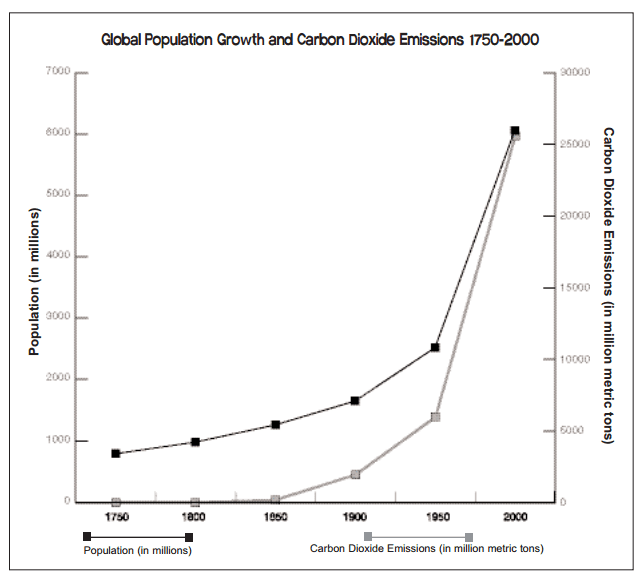This is the third post in a three-part series on exponential growth, doubling time, and the rule of 70. This post makes the population connection by exploring the links between human population growth and environmental quality.
Exponential growth in a finite world is at the crux of many environmental issues including: climate change, biodiversity loss, and deforestation. Human population growth is an excellent example of how exponential growth can negatively affect our environmental systems.
For the majority of human existence, population grew at a slow rate. However, as public health and technology improved in the latter half of the 19th century, many countries in Europe observed sharp a decline in death rate, resulting in rapid population growth. Following WWII, many developing nations began to improve economies and transition from stage 1 to stage 2 of the demographic transition model, causing the population to expand further. This explosive shift in human population occurred within a relatively short period of time. Consider the doubling time of human population. It took roughly 300 years for human population to double from 500 million to 1 billion in 1804; from then, it took 113 years to double to 2 billion, and 47 years to double to 4 billion. Our population is expected to double to 8 billion by the year 2025, and the United Nations projects that human population will reach 9.6 billion by the year 2050.
The concept of exponential population growth becomes a powerful teaching tool when we think about the implications it has on the health of our environmental systems. Simply put, the more people we add to our planet, the greater our collective environmental impact will be. The United Nations Population Fund (UNFPA) cites population and economic growth as the two major threats to environmental quality. A study published in Science on January 16, 2015 found that we have already crossed four of nine planetary boundaries as a result of human activity. The four are: climate change (atmospheric concentrations of CO2), loss of biosphere integrity (mass extinction), land-system change (deforestation), and biogeochemical cycles (phosphorous and nitrogen flows).

Let’s take a closer look at the relationship between population and climate change. Carbon dioxide emissions have increased significantly since the industrial revolution. Global CO2 emissions were 150 times higher in 2011 than they were in 1850. In less than 200 years, we have drastically altered the composition of our atmosphere. In 2014, CO2 concentrations surpassed 400 PPM, the highest levels found on earth in millions of years. If we were to graph CO2 emissions and population growth over time, we would observe a strong positive correlation between the two. Population dynamics, consumption patterns, and climate change are inextricably linked. Lester Brown, founder of the Earth Policy Institute and Worldwatch Institute, states, “If we cannot stabilize climate and if we cannot stabilize population, there is not an ecosystem on earth we can save.”
Fortunately, there are several steps we can take to address population growth. Improving women’s access to basic rights (health care, education, and economic opportunity) and voluntary family planning are ways to slow population growth through empowerment, not coercion. These efforts, in conjunction with strong commitments to reduce unsustainable practices, have the potential to improve the lives of millions of people and lessen our collective impact on the planet.
Explore Population Growth in Your Classroom
Population Education has a wealth of resources for exploring the impact of a growing population on the environment. We have selected three activities that relate specifically to this blog post.
- J-Curve: A graph of world population over time.
- The People Connection: A population dynamics background reading that gives students an overview of world population history, current demographic trends, and the concept of carrying capacity.
- Generating Heat: Students graph carbon emissions and population growth over time and comment on the trends they observe.
Exponential Growth Series
- Post 1: What is Exponential Growth?
- Post 2: What is Doubling Time and How is it Calculated?
- Post 3: Using Population Growth to Explore Exponential Growth and Doubling Time



